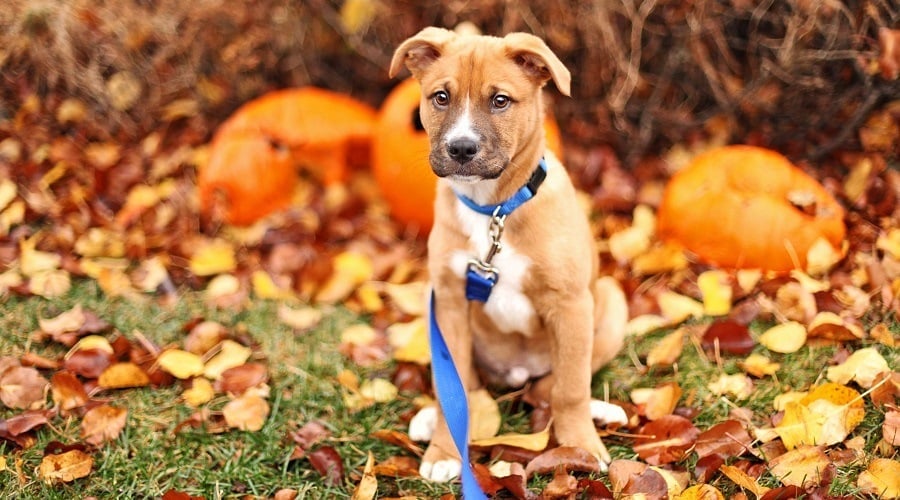Mini Goldendoodle Growth Chart: From Tiny Puffball To Full Grown Fluff
When you purchase through links on our site, we may earn a commission. Here’s how it works.
You brought home a Mini Goldendoodle puppy—part teddy bear, part tornado—and now you’re asking, “How big is this tiny fluff actually going to get?”
Table of Contents
Whether you’re prepping for the zoomies or just trying to find a harness that fits for more than a week, this guide will help you track your pup’s progress with confidence.
From Teacup Teddy To Fluffy Tornado: What’s Normal For Mini Goldendoodle Growth?
Mini Goldendoodles grow quickly, but their development doesn’t always follow a predictable pattern. One week, they’re a round ball of fluff, and the next, they’ve doubled in size and are bouncing off the walls like a wind-up toy with no off switch.

Because they’re a cross between two very different breeds (Miniature Poodle and Golden Retriever), size can vary quite a bit. Even within the same litter, puppies may grow at different rates.
Some stay small and compact, while others shoot up a little taller or fill out faster. Their coat type and overall body shape can also affect how big (or small) they appear as they grow.
Most Mini Goldendoodles reach their full height between 9 and 12 months of age. After that, they continue to gain muscle, body mass, and fluff through 18 months of age. This final stretch helps them transition from roly-poly puppy to polished adult.
Quick Takeaway
- 1 to 2 pounds of weight gain per week until 6 months
- Height typically levels out by 9 to 12 months
- Weight and body mass continue developing until 18 months
- Final size depends on genetics, activity, and feeding habits
If your pup seems to grow in quirky little bursts or suddenly fills out overnight, don’t worry. That’s all part of being a Doodle.
Mini Goldendoodle Puppy Growth Timeline
Mini Goldendoodle puppies don’t just grow, they evolve from palm-sized puffballs into playful, teddy bear-like companions. Here’s what to expect month by month during that crucial first year.
Birth To 2 Weeks: Small, Sleepy & Nursing Nonstop
Your Mini Goldendoodle enters the world blind, deaf, and under a pound. For the first two weeks, all their energy goes into nursing, sleeping, and gaining weight.
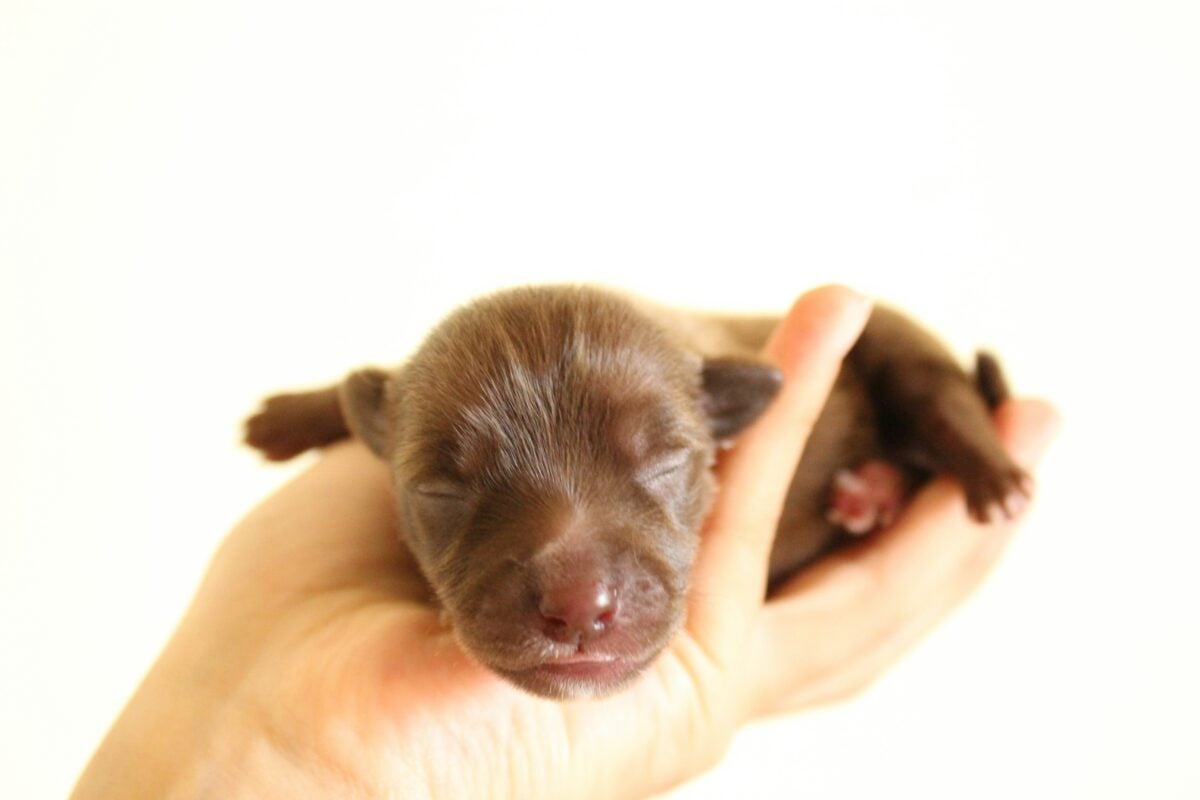
2 To 4 Weeks: Eyes Open, Wobbly Legs Engaged
By the third week, their eyes and ears open. They start scooting and crawling, awkwardly bumping into littermates and discovering the world one waddle at a time.
Watch: These two-week-old Mini Goldendoodles are barely bigger than a slipper—and just as soft. Their eyes are still closed, but the puppy wiggles are already in full swing.
4 To 8 Weeks: Puppy Personality Emerges
Now mobile and curious, your pup begins to walk, play, grow teeth, and develop social skills. They’ll likely reach 5–10 pounds by the time they’re ready to go home with you.
Your Mini Goldendoodle is finding their footing—and their confidence—in the first few weeks in their new home. This is when their unique personality really starts to shine, even in the middle of a big change.
Watch: This brave Dood gets set up for his first night in his crate. Crate training sets the tone for good habits and healthy boundaries. Their world is expanding, and it all starts with a safe, sleepy space.
8 To 12 Weeks: Growth Spurt & Go-Time
By the time your Mini Goldendoodle reaches 8 weeks, the baby stage is fading fast. Their weight gain picks up—often half a pound or more each week—and you may find yourself wondering how they managed to outgrow their harness again overnight.
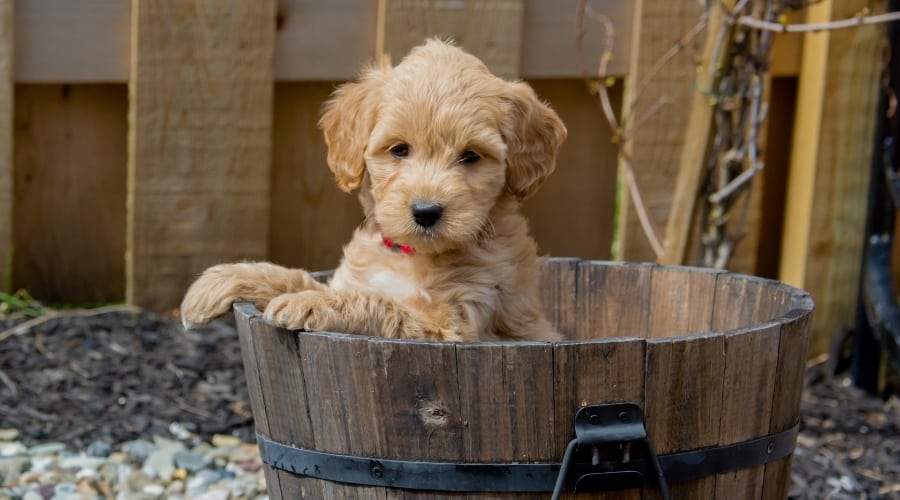
This is a critical developmental phase. Teething kicks into high gear, so don’t be surprised if your pup turns into a sock-seeking land shark. Chew toys are essential, both for comfort and to protect your furniture.
It’s also the most important window for socialization and training. Their brains are like sponges right now, eager to learn but still flexible. Introduce your pup to new sights, sounds, people, and surfaces. This is the best time to start foundational commands like sit, stay, and come.
3 To 4 Months: Fluffy, Feisty, & Teething
At this stage, your Mini Goldendoodle likely weighs between 10 and 20 pounds, depending on their genetic leanings. They may look like a living teddy bear—adorable, wide-eyed, and soft as a cloud—but don’t be fooled. Behind that fluff is a mischievous streak fueled by curiosity and a growing sense of independence.
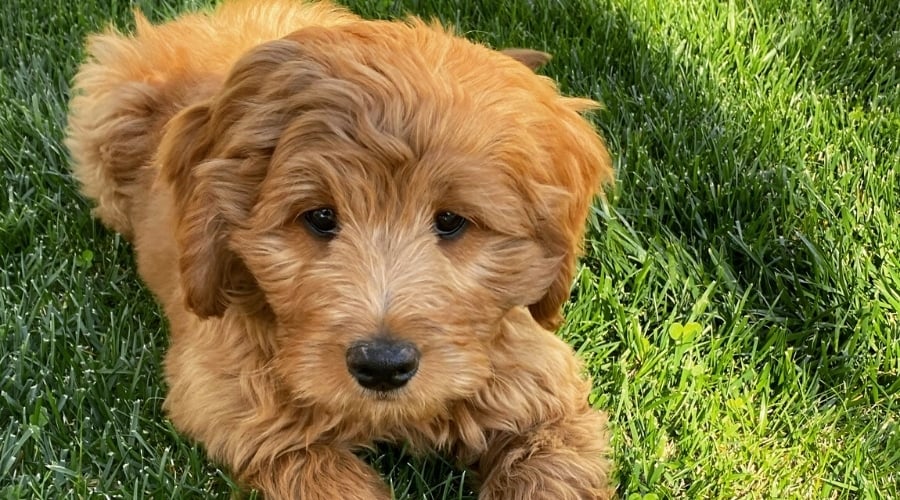
Teething is in full swing, and your pup will chew anything that isn’t bolted down. Shoes, chair legs, fingers—nothing is safe. It’s not personal, it’s developmental. Keep a stash of puppy-safe chews on hand and start redirecting destructive chewing early before bad habits stick.
Behaviorally, this is when your pup starts testing boundaries. Energy levels spike, attention spans shrink, and that adorable face may suddenly “forget” how to sit. Training is essential during this window.
4 To 6 Months: Adolescent Energy Peak
Your Mini Goldendoodle’s back legs might seem to sprout overnight, giving them an adorably awkward, rear-heavy stance. This uneven growth is normal and usually balances out by the end of this stage.
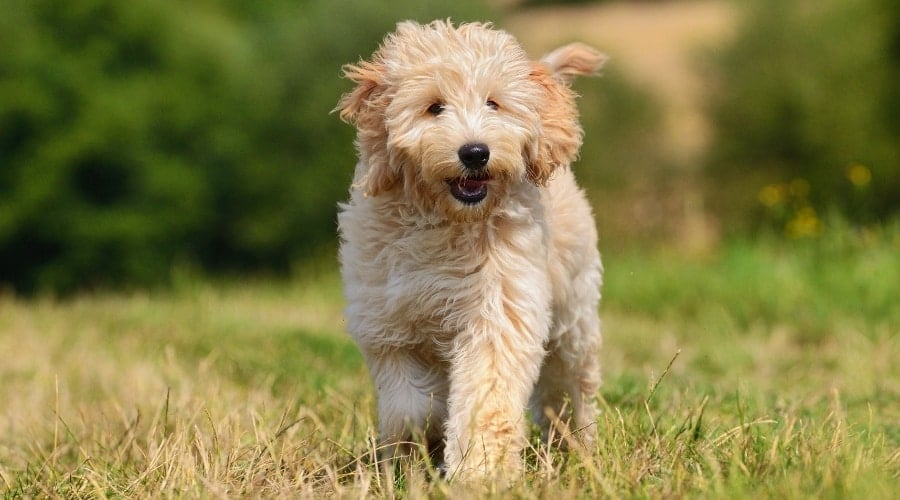
Appetite ramps up to match their energy output. You may notice your pup eating more eagerly or seeming hungrier between meals.
By six months, most Mini Goldendoodles have reached 50–75% of their adult weight. They’re bigger, bouncier, and more determined to explore every corner of your house—and every sock in your laundry.
6 To 9 Months: Maturing Muscles & Mischief
Growth begins to slow, but your pup is starting to fill out with lean muscle. They’ll look more like a proper dog and less like a baby-faced ball of fluff.
That said, they still act like class clowns. Expect random zoomies, selective hearing, and the occasional bout of rebellion.
Training consistency matters more than ever now. Set clear expectations, reinforce commands, and try not to laugh when they give you their best “who, me?” face after chewing a pillow.
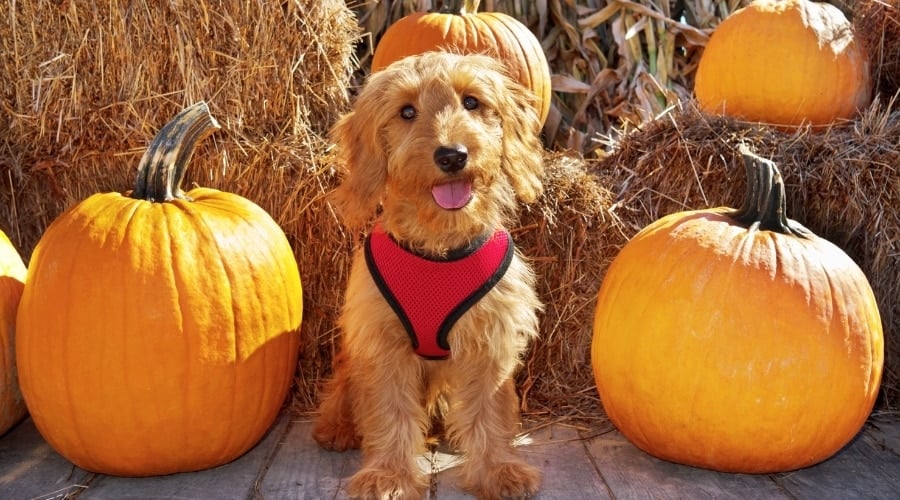
9 To 12 Months: Nearly Grown, Still Goofy
At this point, your Mini Goldendoodle is almost all grown up—at least physically. Most have reached their adult height, and weight gain has significantly slowed. But there’s still a bit of filling out to do as muscle tone develops and their adult coat finishes coming in.
This is also when personality traits start to solidify. You’ll begin to see who your dog truly is: the cuddle bug, the class clown, the neighborhood watch captain. Training is still important, but your dog is likely more focused and less chaotic than during peak puppyhood.
Real Pup Moment: At 11 months old, Jett the Mini Goldendoodle weighs just 12.7 pounds. Some Minis barely crack 15 pounds, while others can tip the scales at 35 or more. It all comes down to genetics.
12 To 24 Months: Filling Out & Settling Down
While your pup may look grown by their first birthday, the next 6–12 months bring slow, steady gains in muscle and maturity. Their coat thickens, their movements smooth out, and their personality settles into its final form.
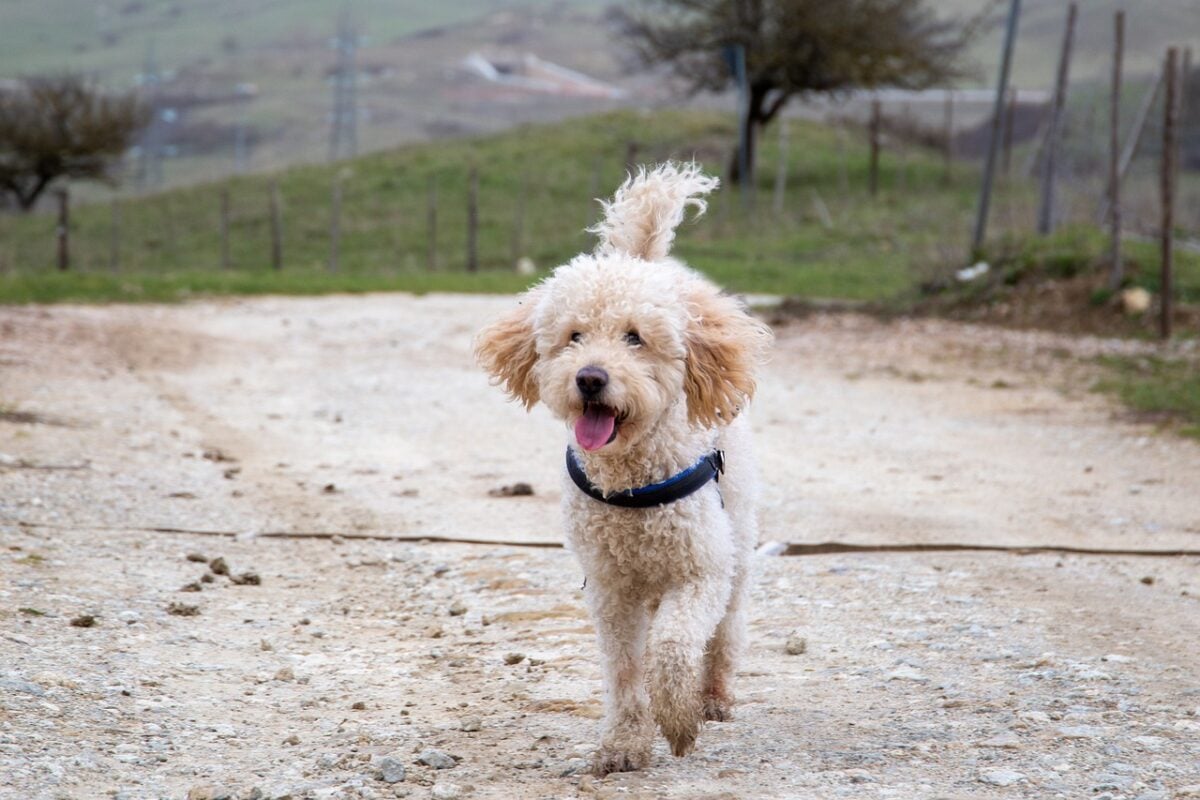
Full-Grown Mini Goldendoodle Size
Mini Goldendoodles are often referred to as “small,” but their adult size varies significantly depending on the genetics of both parents. Some stay compact and lap-sized, while others grow big enough to take up most of the couch.

Most Mini Goldendoodles weigh between 15 and 35 pounds at full size, with a height ranging from 13 to 20 inches at the shoulder. Pups on the lower end likely have a Toy or very small Mini Poodle parent, while those on the larger end may be edging into Medium Goldendoodle territory.
They typically reach their adult height by 10 to 12 months, though muscle and weight may continue to build through the second year.
Quick Facts
- Adult Weight: 15–35 pounds
- Adult Height: 13–20 inches at the shoulder
- Height is usually reached by 12 months
- Full physical maturity by 18–24 months
If your “Mini” is pushing 30+ pounds, don’t panic. Size labels vary, and what really matters is that your dog is healthy, happy, and fits your lifestyle, whether curled in your lap or sprawled across your bed.
Mini Goldendoodle Size Chart
| Age | Male Weight (lbs) | Female Weight (lbs) |
|---|---|---|
| Birth-2 weeks | 0.5 – 1 | 0.5 – 2 |
| 1 month | 1.5 – 2 | 1.5 – 2 |
| 2 months | 2 – 4 | 2 – 3 |
| 3 months | 4 – 6 | 3 – 5 |
| 4 months | 6 – 10 | 5 – 7 |
| 5 months | 10 – 14 | 7 – 10 |
| 6 months | 14 – 18 | 10 -12 |
| 7 months | 18 – 22 | 12 -15 |
| 8 months | 22 – 26 | 15 – 20 |
| 9 months | 26 – 30 | 20 – 24 |
| 10 months | 30 – 32 | 24 – 25 |
| 11 months | 32 – 33 | 32 – 33 |
| 1 year | 33 – 35 | 25 -30 |
| 18 months | 35 – 36 | 30 -32 |
Note: Genetics, nutrition, and activity level all play a role in your dog’s final weight. Some pups may even gain an extra pound or two after their first birthday, especially as they finish filling out.
What Influences Your Mini Goldendoodle’s Growth?
Every Mini Goldendoodle is a genetic surprise package. You might get a petite fluffball who tops out at 15 pounds or a lanky Dood with retriever genes that just won’t quit.
While no growth chart can guarantee your pup’s adult size, understanding the factors behind their development can help you set realistic expectations and spot any red flags early on.
Genetics
Mini Goldendoodles are a mix of two breeds with very different size ranges: the Golden Retriever and the Miniature Poodle. That means your puppy could lean more toward one parent than the other, or fall somewhere in between.
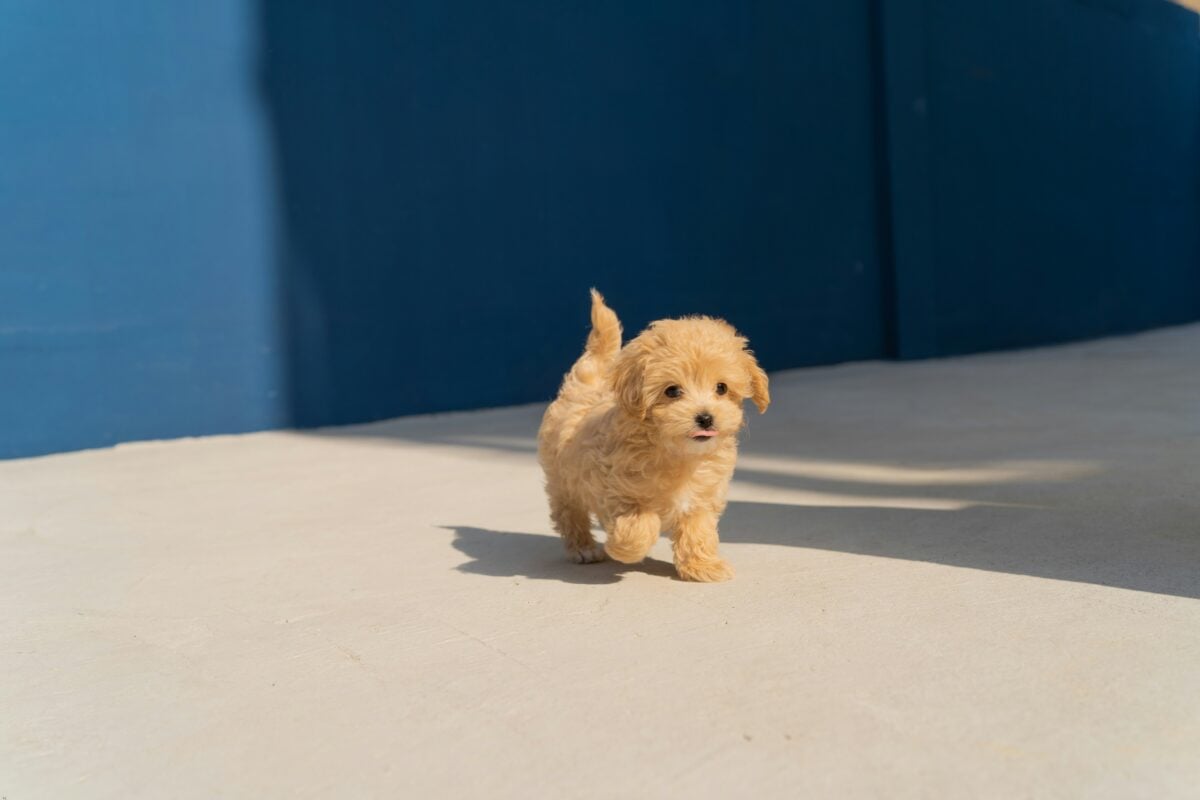
Even within the same litter, puppies can grow up to be very different sizes. Breeders can provide an estimate based on the weight of their parents and previous litters, but there are no guarantees.
Generally speaking, Mini Goldendoodles weigh between 15 and 35 pounds as adults, but some individuals can weigh less or more than that range, depending on their genetic makeup.
Nutrition
Feeding a well-balanced diet is one of the most important things you can do to support healthy growth. Puppies require high-quality food specifically formulated for their developmental stage, ideally one designed for small to medium-sized breeds.

Look for named protein sources, such as chicken, beef, salmon, or lamb, as the first ingredient, along with essential nutrients like calcium and phosphorus, to support bone growth.
Avoid filler-heavy foods, artificial additives, and vague by-product meals. Consistent feeding routines and proper portion sizes also matter.
Overfeeding can lead to excess weight, which strains growing joints. Underfeeding can delay growth or lead to nutrient deficiencies.
Growth Spurts & Plateaus
Mini Goldendoodles don’t grow in a straight line. One week, they’re sprouting legs and gaining weight fast, and the next, they might stall completely.
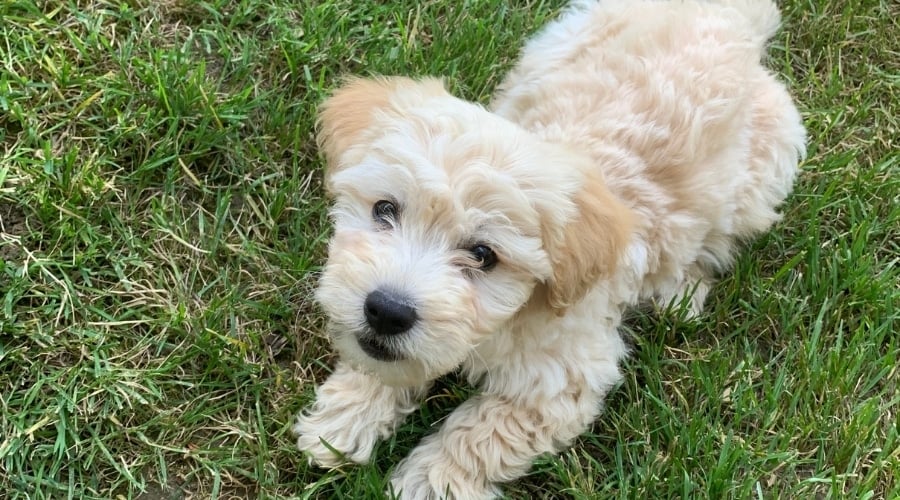
These uneven growth phases are typical. Puppies often experience significant growth spurts around 3 to 6 months, with more subtle gains continuing into their second year.
During these phases, your pup might seem a little clumsy or sore. Support them with gentle exercise, plenty of rest, and a nutrient-rich diet. If you notice sudden changes in your appetite or energy, it’s worth checking in with your veterinarian to rule out any potential health concerns.
Neutering & Spaying
While early spaying or neutering doesn’t necessarily change how big your Mini Goldendoodle will grow, it can influence their mobility and overall health.
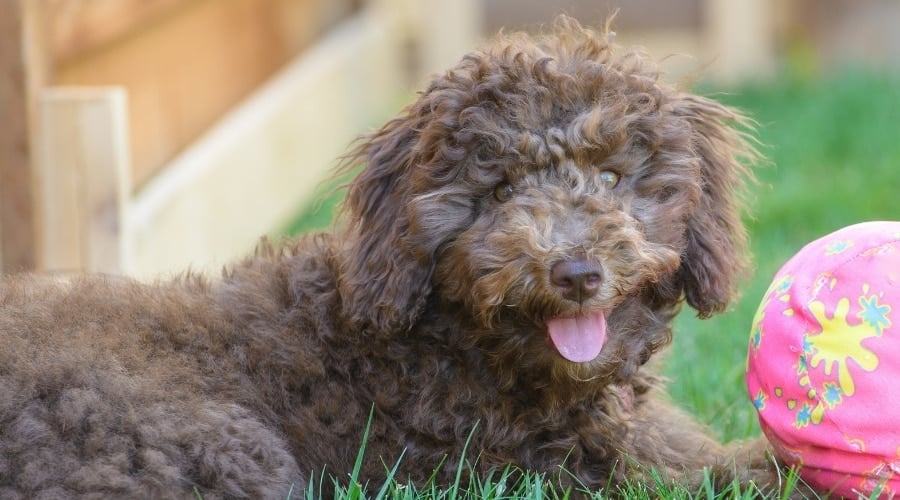
Research conducted by the University of California – Davis revealed that for some dog breeds, early sterilization may be associated with increased risk of health conditions. This includes joint disorders and some cancers.
Many veterinarians recommend waiting until at least 9 to 12 months of age for Mini Goldendoodles, depending on their size, development, and overall health. Your vet can help you weigh the pros and cons and decide the best course for your individual pup.
Physical Health & Activity
Puppies who stay active, get regular vet checkups, and avoid major illnesses tend to grow more predictably. In contrast, chronic infections, parasites, or undiagnosed health issues can stall development.

Mini Goldendoodles are generally healthy, but they can be prone to certain health issues, such as hip dysplasia, patellar luxation, and eye diseases, which are inherited from their parent breeds. Keeping your pup on a consistent wellness routine, including vaccinations, deworming, and routine exams, gives them the best chance to grow strong and stay healthy.
Vet Red Flags To Watch For
Here are a few signs your puppy’s growth may not be on track:
- Limping during a growth spurt
- Sudden weight loss or gain
- Bloated or hard belly
- Refusing food for more than a day
- Extreme lethargy or behavioral changes
- These aren’t just puppy quirks. If anything seems off, call your vet.
Frequently Asked Questions
Wondering if your Mini Goldendoodle will outgrow your lap or stay forever small? Here’s what most new owners want to know about size, growth, and more.
Don’t see your question? Ask us in the comments!
Are Miniature Goldendoodles Expensive?
These dogs range in price from about $1,500 to over $2,000. They may be found at shelters or Doodle rescue groups, but most are bred as designer dogs from higher-priced breeders.
Are Mini Doodles Hypoallergenic?
Yes, the Mini Goldendoodle is considered a “hypoallergenic dog,” but no dog is completely free of allergens.
This breed does not shed much hair and dander due to their Poodle genes. Many Poodle mixes are thought to be better for those who suffer from canine allergies due to their low shedding and dander.
Can A Miniature Doodle Get Bigger Than 35 Pounds?
Some categorize any Doodle between 10 and 50 pounds as a Mini. However, most minis are about 35 pounds. Medium Doodles reach between 15 and 50 pounds.
Is A Mini Goldendoodle The Same As A Full-Size Goldendoodle?
They’re the same mix, just different sizes. All Goldendoodles are a cross between a Golden Retriever and a Poodle, but Mini Goldendoodles are typically bred using a Golden Retriever mom and a Miniature or Toy Poodle dad. Full-size Goldendoodles usually have a Standard Poodle parent instead.
When Are Mini Goldendoodles Fully Grown?
Most Mini Goldendoodles reach their adult height by 10 to 12 months and their full weight by 12 to 14 months. However, they may continue to fill out and gain muscle until 18 to 24 months.
Are Mini Goldendoodles Considered Small Or Medium Dogs?
It depends on their adult weight. Mini Goldendoodles under 25 pounds are often classified as small dogs. Those between 25 and 50 pounds fall into the medium category.
Most minis land somewhere in the 20 to 40 pound range.
More Mini Goldendoodle Tips
Watching your Mini Goldendoodle grow is a joy, but it also brings a multitude of questions. From diet to doodle-specific health quirks, we’ve got you covered.
Check out our guide to the best dog food for Goldendoodles to make sure your pup’s nutrition is on point during every stage of growth. And if you want to learn more about the breed as a whole, don’t miss our complete Goldendoodle breed guide for everything from grooming tips to temperament insights.



